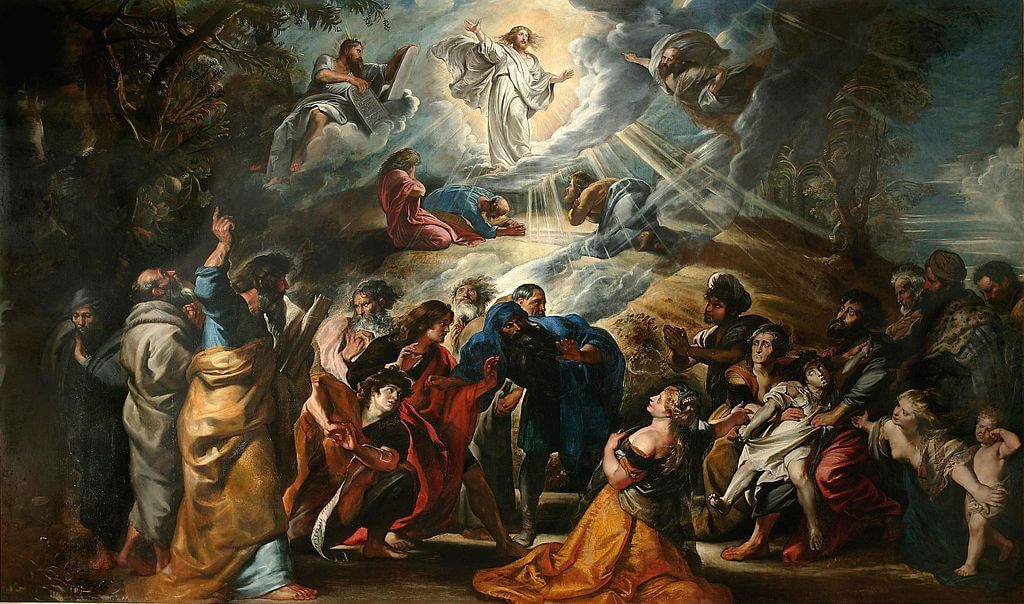

February 14
Transfiguration Sunday
The Transfiguration
2 And after six days Jesus took with him Peter and James and John, and led them up a high mountain by themselves. And he was transfigured before them, 3 and his clothes became radiant, intensely white, as no one[a] on earth could bleach them. 4 And there appeared to them Elijah with Moses, and they were talking with Jesus. 5 And Peter said to Jesus, “Rabbi,[b] it is good that we are here. Let us make three tents, one for you and one for Moses and one for Elijah.” 6 For he did not know what to say, for they were terrified. 7 And a cloud overshadowed them, and a voice came out of the cloud, “This is my beloved Son;[c] listen to him.” 8 And suddenly, looking around, they no longer saw anyone with them but Jesus only.
9 And as they were coming down the mountain, he charged them to tell no one what they had seen, until the Son of Man had risen from the dead.
The gospel according to Mark
Mark 9:2-9
- Take some time to enter into the experience of the disciples. What might they have been thinking and feeling as they went with Jesus up the mountain? As they saw him glorified before them with Moses and Elijah? As they heard the voice of the Father over Jesus? As they suddenly saw only Jesus? As they went down the mountain and afterward? If you were in this story, how would your responses be similar or different to the disciples’?
- Spend a little time looking through the passages leading up to this story. Why might the Transfiguration be sandwiched between Jesus talking about his death and rising (Mark 8:31-38 and Mark 9:9)? Do you see the mingling of suffering and glory in your own life? If so, how? How does it change our worship to reflect that our God’s great victory and glory was brought about through intense suffering?

visio divina
The Transfiguration of Christ by Peter Paul Rubens, circa 1605, oil on canvas, 13’3”x 21”9” / Museum of Fine Arts, Nancy, France
What are you most drawn to in this image?
How are your emotions stirred by it?
Ask the Lord to increase your holy desires.
Flemish painter Peter Paul Rubens was considered one of the pioneers of Baroque art, which featured dramatic movement, rich color and sensuality, appealing to the emotions. He also became a leading voice of the Catholic Counter-Reformation style of painting, which aimed to convey Christian doctrine.
The transfiguration of Christ is a pivotal moment, representing the point where Christ’s humanity meets his divinity. Rubens’ painting illustrates Jesus as the connecting point, the bridge between heaven and us on earth. As Jesus’ mortal body is transfigured, it begins to emanate bright rays of light.
Notice the three apostles, Peter, James, and John, worshiping Jesus below him. On the left of Jesus, Moses holds two stone tablets. The prophet Elijah, on Jesus’ right, is identified with clouds, representing how he was taken up to the heavens.
How would you feel witnessing this mysterious event? The transfiguration was for the benefit of the disciples, to strengthen their faith and confidence in Jesus’ eternal glory during hard times. Can you recall any “mountaintop” experiences of your faith that can help sustain you?
After the intense moment of dazzling brightness featured in the painting, a cloud covered Jesus. Then the Father’s voice is heard, saying, “This is my beloved Son; listen to him!” (Mark 9:7)
The Father’s voice still calls, inviting us to listen to Jesus. Allow yourself to be drawn into Jesus’ loving presence. Be still for a few moments. In prayer we can rest at times and enjoy the Lord’s company as he delights in us.
Settling and Noticing (eyes open) – 2 minutes
- Take a few deep breaths. Settle into this present moment. Open your heart to God.
- Explore all of the details, colors, movements, and shapes in the image. Then focus more intently on a single aspect of the larger image.
Savoring and Pondering (eyes closed) – 1 minute
- Staying with the part of the image you are drawn to, close your eyes, and recreate or visualize that aspect of the image in your mind’s eye.
- While your eyes are still closed, notice any images, feelings, thoughts or memories from your life that might arise in association with this image
Conclusion (eyes opened or closed) – 2 minutes
- How does the image and your response to it meet you at this particular moment of your life?
- Have a little conversation with God about whatever has arisen in your heart during this exercise. You might find it helpful to write down what happened as you prayed with this image.
Musical Devotion
Worship
King of Kings (Hillsong Worship)
Classical
Cantata: "Darzu ist erschienen der Sohn Gottes," BWV 40 (Bach)
Symphony No. 2 in C Minor "Resurrection": V. Finale. Im Tempo des Scherzos by Gustav Mahler


